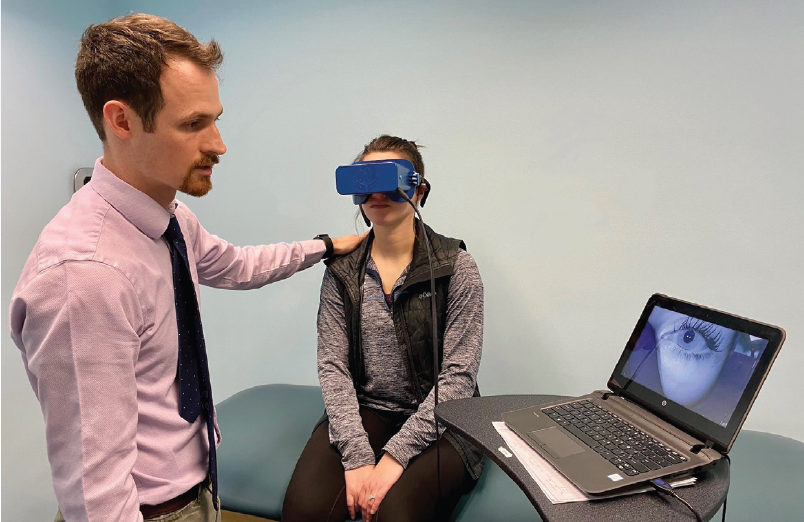The Importance of Physical Therapy Screening for Risk of Falling and Benign Paroxysmal Positional Vertigo (BPPV)
Falling can happen at any age and cause a person significant injury. For someone over 65 years of age, falls are especially concerning. The World Health Organization recognizes falls as the second most common cause of unintentional death in the world (after car accident-related injuries) and states that “older people have the highest risk of death or serious injury arising from a fall, and the risk increases with age.”
Physical therapists have long worked with people to figure out what is causing falls or balance problems and how to best reduce the risk of falling and improve balance. The best way to reduce injuries related to falling is to prevent it in the first place. Increased fall prevention awareness in recent decades has led to important new legislation known as the Stopping Addiction and Falls for the Elderly Act, or SAFE Act.
The SAFE Act includes a provision that primary care providers refer their patients to physical therapy for fall prevention evaluation and services if the person has fallen in the last year. Recent economic analysis of how health care is used has shown the cost-effectiveness of physical therapists’ care for fall-related services, mainly through reduced hospital and emergency room admissions. More than saving Medicare money, this bill is about improving people’s care and helping prevent injuries and death.

Referral to Physical Therapy for fall-related services is ideal because physical therapists are uniquely qualified to evaluate and treat the most common causes of falling. Balance problems can have many contributing factors, including changes in vestibular function, vision, and cognition, decreased muscle power, reduced endurance, decreased sensation in the feet and joints, and changes in coordination. Physical therapists are trained to evaluate these areas, screen for these issues, and analyze how someone walks and moves in different situations.
A vestibular physical therapist is particularly well suited to screen for benign paroxysmal vertigo, an issue that can both cause falls and be caused by falls. BPPV is an issue where tiny calcium carbonate crystals that are meant to be in one part of the vestibular system in the inner ear come loose and go into one of the semi-circular canals, which are little tubes that sense turning head movements
_____________________________________
1 https://www.who.int/news-room/fact-sheets/detail/falls
2 https://www.apta.org/news/2024/03/12/falls-legislation-safe-act
3 https://www.valueofpt.com/
_____________________________________
When the crystals move in the canals, they stimulate the inner ear and signal to the brain that the head is turning, even though it isn’t. This typically creates a false sense of movement, usually a spinning sensation called vertigo.
It turns out that not everyone who has BPPV experiences vertigo or even a dizziness sensation. Someone with BPPV may feel more off balance with movement due to the crystals being out of place but report no dizziness. When we test them with video goggles, however, we will see the classic involuntary eye movements, called nystagmus, used to diagnose BPPV accurately. Treating their BPPV through positioning maneuvers that guide the crystals out of the canals will help their balance improve.
A new study from a specialty falls and balance clinic in Melbourne, Australia, found that 1 in 4 patients they saw for falls risk who had BPPV had no symptoms of dizziness! This is a great example of why we screen people for BPPV when there is a sudden change in balance function or a recent fall–even if they do not complain of dizziness.

Of course, if a patient feels dizzy, this dizziness can also lead to a fall. Treating someone’s dizziness, understandably, will help reduce their risk of falling. This has now been supported by large-scale research. A 2023 study published in the Journal of the American Medical Association (JAMA) found that using physical therapy decreased fall risk in patients in the US who had dizziness. The study found that 7% of adults being evaluated for dizziness had a fall resulting in a medical encounter within a year of experiencing dizziness. Receiving physical therapy within 3 months of the initial dizziness visit was associated with an 86% decrease in the odds of falling.
This underscores the value of physical therapy care—particularly by a physical therapist with training and expertise in treating dizziness—for those who have fallen or feel at risk of falling or for those who are experiencing dizziness. If your healthcare provider recommends you seek physical therapy care due to a fall, following through with the therapy is in your best interest. And if you are dizzy, you can reduce your risk of falling by receiving physical therapy. The physical therapists at WWSPT would be happy to help you reduce your risk of falling and feel more confident in your balance again.
Dr. Greg Synnestvedt, PT, DPT,
WWS Physical Therapy and Vestibular Rehabilitation
Doylestown, PA.
(215) 489-3234
_____________________________________
4 Susan Hyland, Lyndon J. Hawke & Nicholas F. Taylor (2024) Benign paroxysmal positional vertigo without dizziness is common in people presenting to falls clinics, Disability and Rehabilitation, DOI: 10.1080/09638288.2024.2320271
5 Marmor S, Karaca-Mandic P, Adams ME. Use of Physical Therapy and Subsequent Falls Among Patients With Dizziness in the US. JAMA Otolaryngol Head Neck Surg. 2023;149(12):1083–1090. doi:10.1001/jamaoto.2023.2840
